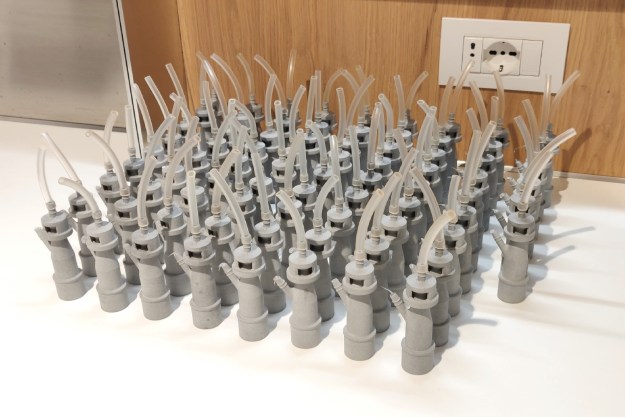
This past weekend, I spent hours perusing the do-it-yourself onslaught that is Maker Faire New York, an annual, kid-friendly event that celebrates science and individual ingenuity. The show was predictably packed with homemade Arduino-powered robots, hobbyist drones, and Etsy-like crafts. But one category clearly stole the show: 3D printing.
Hoards of enraptured DIYers crowded around the booth of MakerBot, a Brooklyn-based 3D printer company that just launched its latest product, the Replicator 2. Unlike many of the other 3D printers showcased at Maker Faire, the $2,200 Replicator 2 comes pre-assembled, and includes easy-to-use software for turning CAD designs — the files that tell the 3D printer what to print — into real objects.
While MakerBot appears to be floating atop a cloud of palpable excitement from the DIY crowd, policy experts warn that the many industries that could be threatened by accessible 3D printing technology may soon begin pushing for legislation that will pop the 3D bubble.
3D printing 101
For the uninitiated: 3D printers work much like an ink printer. But instead of ink, a more substantial material (often a kind of polymer) is fed out of the machine, layer by layer, to build up whatever object it is that a user decides to make. Here’s a quick video I shot this weekend of one 3D printer in action. (It’s making a toy robot.):
The excitement that flutters around 3D printing is entirely understandable, even for a crotchety skeptic like myself: Consumer-level 3D printing has the very real ability to disrupt an unfathomable number of industries, from manufacturing to shipping, to you-name-it. Those excited about 3D printing, like a number of Maker Faire attendees I spoke with, all dreamed of a future when, rather than ordering a new thing — say, a replacement part for your vacuum cleaner — you simply download the CAD design file for the item, and print it out. In fact, that future has already arrived.
MakerBot’s Replicator 2 is clearly the next evolution of home 3D printing, which enthusiasts believe will only become more popular as prices fall, designs become more readily available and user-friendly, and the user interfaces improve to the point when anyone can print out out anything at the push of a button. Automatically creating anything you want or need will be as simple as microwaving a baked potato.

Danger!
There is, of course, at least one major snag in this plan: The industries that would almost certainly be put out of business by 3D printing, were it to become a household norm, are not going to go down without a fight, say legal experts. And what will be their weapon of choice? Intellectual property laws, of course.
The presumed fear is that people will eventually be able to download CAD files, or create their own with advanced 3D scanners, of anything in the world: shoes, televisions, guitars, iPhones, and on, and on. Yes, 3D printer users would likely have to create these object piece-by-piece (as is currently the case). But in the end, they would still have a complete product. So just as the movie and music industries have gone after bit-torrent files and the sites that share them in their war against online piracy, so too will manufacturers attack CAD files and CAD file sharing, experts watching the space believe.
“As incumbent companies begin to see small-scale 3D printing as a threat, they will inevitably attempt to restrict it by expanding intellectual property protections,” wrote Michael Weinberg, a staff lawyer for Public Knowledge, in a recently published white paper on 3D printing. “In doing so they will point to easily understood injuries to existing business models (caused by 3D printing or not) such as lost sales, lower profits, and reduced employment.”

Prepare for battle
This is a cycle we’ve seen before. Weinberg notes that “incumbent companies” put up similar fights against the printing press, photo copiers, VCRs, and even the personal computer. In the case of the PC, writes Weinberg, “these interests pushed through laws like the Digital Millennium Copyright Act (DMCA) that made it harder to use computers in new and innovative ways.” The challenge for the fledgling 3D printing industry is to understand “how intellectual property law relates to 3D printing, and how changes might impact 3D printing’s future,” so that it will be ready to fight “before incumbents try to cripple 3D printing with restrictive intellectual property laws.”
While patent and trademark law may be used by established industries to trample 3D printing, both have a number of limitations that will make them difficult to use against home 3D printing, explains Weinberg. Instead, threatened industries will likely seek to strengthen copyright laws to make the recreation of objects — or even the creation of objects that perform the same function as a copyrighted item — illegal.
“Useful objects could be protected for decades after creation. Mechanical and functional innovation could be frozen by fears of massive copyright infringement lawsuits,” warns Weingberg. “Furthermore, articles that the public is free to recreate and improve upon today (such as a simple mug or bookend) would become subject to inaccessible and restrictive licensing agreements.”
At the very least, says Weinberg, “rightsholders could insist that, in order to avoid liability, 3D printer manufacturers incorporate restrictive DRM that would prevent their printers from reproducing CAD designs with ‘do not copy’ watermarks.”
What next?
As mentioned, the goal of Weinberg’s paper is to prepare the 3D printing industry and its customers for a coming legal battle over this emerging technology. For the moment, however, 3D printing remains a niche hobby — and an expensive one at that. Even the least expensive 3D printers, ones that must be put together at home and almost require a computer science degree to get working properly, cost around $1,000. And most of what can be made using a 3D printer are small nicknacks: figurines, gears, or nifty pieces of artwork — items that littered many of the Maker Faire booths this weekend. But if the technology were free to advance at its current rate, say enthusiasts, one day soon, it may be possible to create an unlimited number of things, both original creations or replicas of other products.
If Weinberg is right, so-called incumbent companies will flex whatever muscles they can to stop that day from ever arriving. And if you believe the hype around the possibilities of 3D printing, it’s hard to not feel at least a bit of sympathy for these companies (and those they employ); the danger of disruption really is, it seems, that high. After all, “you wouldn’t steal a car,” as the now-infamous anti-piracy ad asserted. No — but what if you could download one?
Editors' Recommendations
- 3DMakerpro’s Seal is a pocket-sized scanner to make next-gen precision 3D prints
- Need a last-minute Halloween costume? Check out these 3D-printable getups
- The future of making stuff: Inside the evolution of 3D printing with Formlabs
- Father’s Day Gift Idea: These cheap 3D printers are on sale for less than $300
- 3D printing lets hospitals make ventilator substitutes with common equipment


